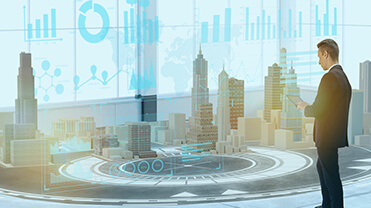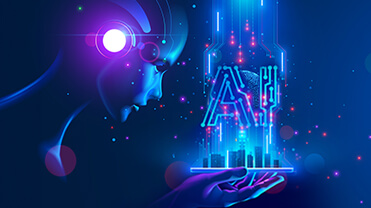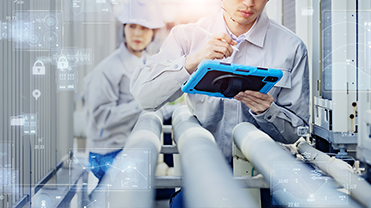Digital twins – the key to unlocking
the full potential of IoT
As the world moves towards a more connected future, Internet of Things (IoT) technology is playing an increasingly vital role in our lives. IoT devices are being used to automate the built environment, optimise energy efficiency, and enhance safety conditions. This exponential growth makes managing and optimising IoT device performance increasingly complex and demanding. That’s where digital twins come in, a ground-breaking concept that holds the key to unlocking the full potential of IoT.
Simply put, digital twins are virtual exact counterparts (or ‘twins’) of physical objects, processes, or systems. These can be absolutely anything from buildings and factories, to entire cities; Singapore and Shanghai both have digital twins for the entire cities. By leveraging real-world data to replicate a virtual model of any asset or service, digital twins bridge the gap between physical and virtual worlds.
Integrating real-time data from sensors embedded in physical devices, they mimic the behaviour, characteristics, and performance of their physical counterpart with remarkable accuracy which can then be used to run simulations and test different use cases to drive actionable insights. Furthermore, when integrated with Artificial Intelligence (AI) and Machine Learning (ML) algorithms, digital twins facilitate advanced analytics to optimise processes and enhance overall performance, creating a cost-effective, efficient, and reliable approach to drive innovation across industries.
Where did the digital twins concept come from?
Technology experts have been playing with the theory of using computers to create a digital copy of the physical world since the 1960s and the idea was put to paper in 1991, in David Gelernter’s book, ‘Mirror Worlds’. The concept of digital twins was first applied to manufacturing in 2002, but it was NASA’s John Vickers who introduced the term ‘digital twin’ in 2010.
Since then, digital twins have been used in various industries, including automotive, aerospace, and healthcare. However, with the advent of IoT, digital twins have become an integral part of this ecosystem.
Digital twins : more reality than simulation
Even though both digital twins and simulation wield the power of digital models to replicate processes and products, they differ in several key aspects.
Digital twins run on a real-time flow of data thus accurately reflecting the present value of their physical counterparts whereas simulations operate independently without relying on real-time data. Additionally, simulations are mostly confined to single processes, but digital twins offer a richer virtual environment for studying multiple processes.
With constantly updated and diverse data, coupled with the computational power of virtual environments, digital twins have a broader scope and greater potential to test complex use cases as compared to traditional simulations.
Understanding the value of digital twins
Digital twins enable a powerful and unprecedented view into how an asset is performing. Acknowledging the distinct requirements of each industry, they offer significant benefits throughout different stages of project and product lifecycles. Digital twin solutions can vary widely, from improving maintenance, to performing monitoring and risk analysis in a variety of domains. This information can be used to schedule predictive maintenance, minimise downtime, and optimise operations.
Given how crucial it is to collect real-time data across diverse systems for analysis – and many organisations face a challenge here – digital twins can also be used as a platform to monitor and analyse complex physical systems, providing users with comprehensive insights. This virtual environment then assists organisations to analyse how a product performs under various conditions and validate them, while identifying potential safety hazards.
Explore EdificeEdge, Softdel’s award-winning IoT gateway platform, that unlocks ‘trapped’ data from a multitude of IoT devices enabling you to make informed, data-driven decisions.
Digital twins in the real world
In smart factories, digital twins can be used to model and simulate the entire factory layout and equipment. Sensors placed on the factory floor can collect real-time data on machine performance, energy consumption, and material usage. This data can be fed into the digital twin to create a virtual representation of the factory. The digital twins can then be used to simulate various scenarios, such as changing the production line layout or introducing new equipment. Engineers and operators can use the digital twin to optimise the factory’s performance, carry out effective research, provide training, reduce downtime, and improve overall efficiency.
Smart buildings are another domain where digital twin technology is making a significant impact. A digital twin can be created to represent the entire building, including its infrastructure, systems, and occupants. By integrating real-time data from sensors, energy management systems, and other IoT devices, the digital twin can provide a comprehensive view of the building’s operations. Facility managers can keep track of energy consumption from systems like HVAC, lighting, and more while monitoring the systems themselves — in real time. They can identify patterns and anomalies, allowing them to optimise energy usage and reduce operational costs. The digital twin can simulate different scenarios to help managers assess the impact of changes in settings, such as adjusting temperature or occupancy schedules, before implementing them in the physical environment. Predictive capabilities also allow facility managers to schedule maintenance tasks with the least disruption, for a better occupant experience.
With the adoption of digital twin technology predicted to reach USD 73.5 billion by 2027, there will be billions of assets represented by digital twins within the next five years. This projected growth makes it clear that digital twins are poised to become a fundamental aspect of the IoT ecosystem. By leveraging the potential of digital twins, organisations can unlock unprecedented efficiencies, cost savings, and operational excellence in the increasingly connected world of IoT. They can also benefit from programs like the Digital Twin Consortium, to learn and advance the use digital twins.
See how Softdel’s experience in building automation, industrial, and process automation, as well as our accomplishment in designing a powerful edge computing platform for the oil and gas industry has incentivised industry leaders to partner with us as they expand their digital twin ecosystem. Read our recent case-study about a digital twin platform built for asset performance management (APM).






